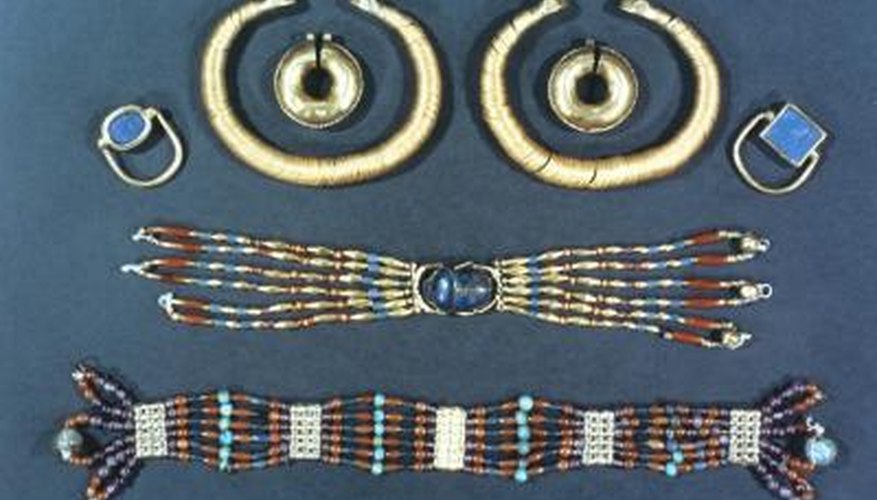Jewellery was an important part of ancient Egyptian culture from earliest times. Jewellery served a variety of purposes besides being beautiful. Types and quality of jewellery served as marks of social status. Some items of jewellery, such as scarabs, were also used as personal seals or signets. Other types of jewellery were used as amulets for protection against bad luck or disease. Men, women, and children of all social classes typically wore jewellery of some kind, even if it was just a small, inexpensive piece.
Drilling and Carving

Some of the earliest forms of Egyptian jewellery were beads made from stone or shell. Stone and shell can be shaped using sand, and simple drills such as the bow drill can be used to make holes in beads or pendants for stringing.
Drilled stone and shell appear as early as 5000BC. A variety of stones were used to create beads, including carnelian, turquoise, lapis lazuli, and steatite. Sand was often used to polish and smooth beads. Carving with copper tools could also produce fine details, such as the decoration seen on the bottom surfaces of scarabs.
- Some of the earliest forms of Egyptian jewellery were beads made from stone or shell.
- A variety of stones were used to create beads, including carnelian, turquoise, lapis lazuli, and steatite.
Metalworking

The Egyptians also worked a variety of metals to produce jewellery. Metal can be hammered into shape or melted and poured into moulds to create jewellery. It can also be extruded into wire for stringing beads or other pieces. Some of the earliest metal worked was gold. Gold is relatively soft and easy to work.
- The Egyptians also worked a variety of metals to produce jewellery.
- It can also be extruded into wire for stringing beads or other pieces.
Silver was also used for jewellery production, but was relatively rare compared with gold. Gold and silver were combined to form electrum, another popular metal in Egyptian jewellery. Both gold and silver were used for jewellery as early as 3500 B.C.
Copper and bronze were also used to produce some forms of jewellery beginning as early as 4000 B.C. In later periods of Egyptian history, bronze was a very popular material for producing small statues of deities to be worn as amulets or kept as figurines.
Faience and Glazing

Ancient Egypt is famous for a material called faience. It is best known as a turquoise blue material, but could be made in a variety of different colours.
Faience is a combination of quartz and other materials that is superheated until the surface becomes glazed or glassy. It can be placed into moulds to create beads, scarabs, bowls, and other items or can be carved and drilled much like some forms of stone.
Faience was often used in place of other, more expensive materials such as carnelian or lapis lazuli or turquoise, as it was comparatively less expensive and sometimes easier to work with.
- Ancient Egypt is famous for a material called faience.
- Faience was often used in place of other, more expensive materials such as carnelian or lapis lazuli or turquoise, as it was comparatively less expensive and sometimes easier to work with.
Glasswork
Glass appears rarely before the New Kingdom (ca 1550 B.C.), when Egyptian artisans began producing large amounts of glass in various colours. Glass was often used for inlays on larger pieces of jewellery or for beads. Glass could be coloured to imitate various types of stone, such as lapis lazuli, that were comparatively rare and expensive.
- Glass appears rarely before the New Kingdom (ca 1550 B.C.
- ), when Egyptian artisans began producing large amounts of glass in various colours.
- Glass could be coloured to imitate various types of stone, such as lapis lazuli, that were comparatively rare and expensive.
